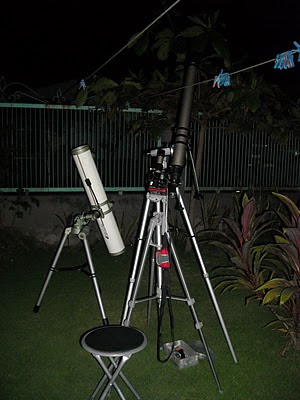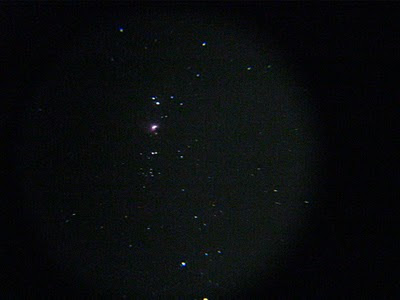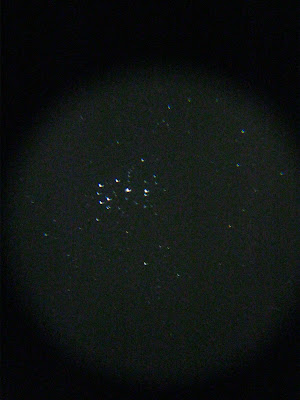Here are the photos that I took using the afocal method. All photos were taken handheld using my Canon A495 digital camera since my tripod was doing some work back at the church. Telescope used is a 60mm equatorially mounted refractor and a 22mm Ramsden Eyepiece. Enjoy!
Tuesday, January 25, 2011
Lunar Snapshots
While on my way home last sunday, I saw the moon glowing low in the horizon. Upon arriving, I quickly set up my 60mm refractor to get some shots of the moon. Upon looking at the eyepiece, I got excited again at looking at this heavenly body after ignoring it for a few months. The moon really never fails to amaze anyone no matter how many times it is viewed.
Here are the photos that I took using the afocal method. All photos were taken handheld using my Canon A495 digital camera since my tripod was doing some work back at the church. Telescope used is a 60mm equatorially mounted refractor and a 22mm Ramsden Eyepiece. Enjoy!
Here are the photos that I took using the afocal method. All photos were taken handheld using my Canon A495 digital camera since my tripod was doing some work back at the church. Telescope used is a 60mm equatorially mounted refractor and a 22mm Ramsden Eyepiece. Enjoy!
Labels:
AAP,
Amateur Astronomy,
Astronomers Anonymous of the Philippines,
Astronomy in the Philippines,
astrophotography,
Lunar,
Moon,
Moon Craters,
Photos of the moon
Friday, January 21, 2011
Finderscope Astrophotography
I must say that I am pushing the envelope, so to speak, in my astronomy adventures. A few weeks ago, I set up my telescope to enjoy the clear night and do some astrophotography. However, my simple equatorial mount and astrophotography setup frustrated me because I had to keep adjusting the telescope to track the objects that I am photographing and at the same time adjust the camera to follow the telescope's adjustments - a perfect combination for irritation and frustration. Since everything was manually adjusted and I only have two hands, it was really really hard. Contrary to my statements before, you can indeed be limited by your equipment sometimes - especially if you have the knowledge but not the proper tools to execute and fulfill your plan which is of course, good astrophotography. This was made harder by the fact that I was trying to photograph the Orion's nebula and the Pleiades star cluster which required quite longer exposure times than photos of the moon or videos of the planets.
However, as Newton said, for every action, there is an equal and opposite reaction. And in this case, I did not want to sleep without getting good astrophotos. This is where the finderscope gets in. Since the finderscope is a low power scope with a wide field, I wont have much trouble adjusting since it does not magnify the subject and its movement. Thus, finderscope astrophotography was born. For these photos, I am using my new Canon A495 digital camera (a Christmas gift from Maureen Santos) mounted on a generic camera tripod and my 6x30 finderscope which is of excellent quality.
 |
| Here was my setup for the night. |
I brought out my two telescopes to be able to do a comparison but it was such a hassle to use my two primary telescopes because I had to adjust them from time to time manually which led to blurred photos. However, I must note that my two primary telescopes are very good performers. Its just that I do not have the proper camera adaptor and motor drive to move up to the next level of astrophotography - deep sky astrophotography.
 |
| Finderscope Astrophotography Setup |
 |
| Finderscope Astrophotography Setup |
 |
| Finderscope Astrophotography Setup |
This setup may look simple but I was surprised with the results. Sadly, I am having troubles with image processing at the moment so I will instead post the individual images that I took during the night for your reference. All photos were again, taken with a Canon Powershot A495 Digital Camera at ISO 400, exposure times : 8 seconds or 10 seconds (yes, my camera does allow long exposures but not control of aperture - you can check out the specifications on the internet).
Here are the photos of the Orion nebula as seen through the finderscope's rich field of view. All images are unedited and are JPEGs straight from the camera.
And here are photos of the Pleiades star cluster. Again, the finderscope's rich field of view positions the Pleiades perfectly. All images are unedited and are JPEGs straight from the camera.
And finally to top everything off, a picture of myself doing what I love during the night!
Equipment does matter sometimes but if you have passion and a bit of imagination, you can do something with very very limited equipment - even a 6x30 finderscope which I'm sure is underestimated by the majority of people. Its not about equipment - its about you and how you find a way to do things.
Labels:
AAP,
Amateur Astronomy,
Astronomers Anonymous of the Philippines,
Astronomy in the Philippines,
astrophotography,
astrophotography in the philippines,
Orion Nebula,
Pleiades
Subscribe to:
Posts (Atom)













































